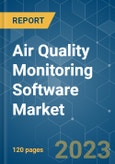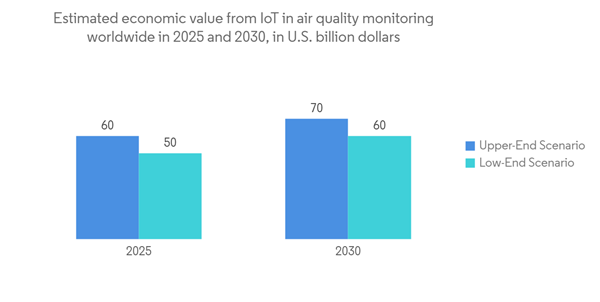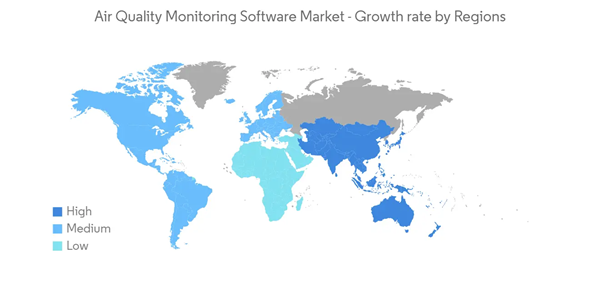The Air Quality Monitoring Software Market is expected to grow at a CAGR of 6.3% for the next five years. More people are required to assess project needs and comprehend building projects' internal or external components.
In December 2022, Bosch launched an effective intelligence performance management system in the Middle East powered by Digital Twin. The newest digital transformation solution from Bosch, powered by Digital Twin running on Microsoft Azure, assists clients in the industrial and energy sectors to forecast the future by locating bottlenecks and reducing constraints, boosting decision-making to influence business outcomes.
In October 2022, Siemens signed a strategic agreement with Ecolab to reduce greenhouse gas emissions and improve the production process. Together, the businesses are introducing Climate Intelligence, powered by ECOLAB3DTM and Siemens gPROMS. This novel solution enables users to virtually model various scenarios involving their water and energy systems in order to find opportunities for water and energy savings while also reducing greenhouse gas emissions.
This product will be delivered within 2 business days.
Key Highlights
- Over the forecast period, the market is expected to be driven by increasing government initiatives for developing environmentally friendly industries, growth in the industrial sector that is creating a demand for air quality monitoring software, and strict government regulations for efficient air pollution monitoring and control.
- The market for air quality monitoring software is primarily driven by the increasing installation and use of air quality monitoring systems in both developed and developing nations. Additionally, there is a need for more skilled professionals to monitor and control the software and regular R&D infrastructure to develop a cost-effective monitoring system for developing countries.
- However, one of the major challenges associated with air quality monitoring software is the high cost of installation and constant invigilating of the readings. There is also a need for skilled persons for pollution control and monitoring measures and more research and development infrastructure for expanding cost-effective air maintenance technology.
- As the relationship between air quality and health, well-being, creativity, and productivity becomes increasingly clear, indoor air quality (IAQ) is receiving more attention than ever. Most major groups and agencies worldwide rank poor IAQ as one of the top five health concerns. As a result, proper indoor air quality is becoming a bigger priority for organizations, governments, institutions of higher learning, building owners, and managers worldwide.
- One of the main causes of death worldwide is air pollution. In the major developing Asian countries, there are numerous air quality problems, yet during COVID-19 lockdowns, urban air quality improved because of the decrease in public movement and fuel consumption. As a result, fewer industries needed air quality assessment equipment. However, due to rising worries about air quality and the rise of industrialization in many nations, post the relaxation of the COVID-related guidelines, the market is projected to accelerate soon.
Air Quality Monitoring Software Market Trends
Indoor Air Quality Monitoring (IAQM) Demand Propelling Growth
- The software for monitoring indoor air quality is anticipated to dominate the industry. The factors can be attributed to the accurate assessment and control of indoor air pollution because dust, smoke, volatile organic compounds from varnishes and paints, odors, occupation-related contaminants, gases, particulate matter, pesticides, solvents, and microbial contaminants affect indoor air quality.
- Due to the growing awareness among end-users about lowering pollution and maintaining a threshold level of air quality inside the premises of the industrial vertical, the indoor application sector is anticipated to see a higher growth rate throughout the projected period. The rising use of air quality monitoring systems for interior applications, such as in offices, medical labs, etc., is one of the most recent developments in the market for air quality monitoring software.
- Governments have announced legislation for efficient monitoring and management of air pollution, which is anticipated to accelerate the use of indoor air quality monitors. Over the projected years, the market is expected to be driven by increasing government initiatives to create a demand for air quality monitoring software and strict government regulations for efficient indoor air pollution monitoring and control. The U.S. Environmental Protection Agency's Indoor Air Quality Division seeks to increase public awareness on indoor air quality.
- IoT monitoring systems are considered the most trustworthy options for IAQ measurement, considering the battery life expectancy and dependable single-hop communication capacities. These systems require less maintenance work since they have reduced latencies and less power usage. Real-time monitoring systems built on IoT are called smart systems, and therefore, most academics and manufacturers are drawn to this design. According to experts, the IoT system can monitor many factors without affecting system efficiency.
- By 2025, it is predicted that IoT services and products for air quality monitoring would be worth between USD 50 and USD 60 billion. By 2030, this figure is anticipated to increase to between USD 60 and USD 70 billion.
Higher Usage in The Asia Pacific Region
- In Asia, air pollution is reaching alarmingly high levels, which is bad for the population's health. The current state of affairs is primarily a result of the expanding industrialization of emerging nations, which has increased the number of chemical pollutants in the countries - some of which are also lethal.
- Major cities, including Shanghai, Zabol, Riyadh, Delhi, Dhaka, and Kolkata, have seen a sharp rise in air pollution. Because they release hazardous substances such as particulate matter, carbon monoxide, and sulfur dioxide, vehicles play a significant role in emissions. The particles are carcinogenic since they may enter the circulation and lungs deeply, resulting in heart attacks and lasting DNA alterations.
- Due to factors such as the commercialization of cutting-edge products, rising industrialization, and the adoption of stringent air pollution regulations in this area, Asia is expected to have the greatest market share. Also, in developing countries like India and Bangladesh, infrastructural activities are continuously growing, causing environmental pollution. This is a driving factor for air quality monitoring software in this region.
- Furthermore, governments have started taking steps to limit the flow of pollutants into the atmosphere. Meanwhile, by digitalizing a city's infrastructure, including its transportation systems and wireless sensors, more government measures to create smart cities are also predicted to spur consumer demand for sophisticated software for monitoring air quality.
- According to the leading British oil and gas company, BP, in the previous year, 17.74 billion metric tonnes of carbon dioxide emissions were created in the Asia-Pacific area. This exceeded the sum of the emissions from any other area that year. Nearly 60% of the CO2 emissions in the Asia-Pacific region and 31% of the global total were produced by China alone. North America, where 5.6 billion metric tonnes of CO2 were released into the atmosphere in 2021, was the second most polluting area.
Air Quality Monitoring Software Market Competitor Analysis
The Air Quality Monitoring Software Market is fragmented as it currently consists of many players. Several key players in the market are in constant efforts to bring advancements. A few prominent companies are entering into collaborations and expanding their global footprint in developing regions to consolidate their positions in the market. The major player in this market includes Siemens AG, Thermo Fisher Scientific., Robert Bosch GmbH, Aeroqual Ltd., Honeywell HBT, and several others.In December 2022, Bosch launched an effective intelligence performance management system in the Middle East powered by Digital Twin. The newest digital transformation solution from Bosch, powered by Digital Twin running on Microsoft Azure, assists clients in the industrial and energy sectors to forecast the future by locating bottlenecks and reducing constraints, boosting decision-making to influence business outcomes.
In October 2022, Siemens signed a strategic agreement with Ecolab to reduce greenhouse gas emissions and improve the production process. Together, the businesses are introducing Climate Intelligence, powered by ECOLAB3DTM and Siemens gPROMS. This novel solution enables users to virtually model various scenarios involving their water and energy systems in order to find opportunities for water and energy savings while also reducing greenhouse gas emissions.
Additional benefits of purchasing the report:
- The market estimate (ME) sheet in Excel format
- 3 months of analyst support
This product will be delivered within 2 business days.
Table of Contents
1 INTRODUCTION
4 MARKET INSIGHTS
5 MARKET DYNAMICS
6 MARKET SEGMENTATION
7 COMPETITIVE LANDSCAPE
Companies Mentioned (Partial List)
A selection of companies mentioned in this report includes, but is not limited to:
- Cambridge Environmental Research Consultants Ltd
- Lakes Environmental Software
- Thermo Fisher Scientific Inc.
- Siemens AG
- Robert Bosch GmbH.
- Aeroqual Ltd.
- Horiba Ltd
- Envirotech Online.
- Merck KGaA,
- Honeywell HBT
- Teledyne Technologies Incorporated.
- Hawa Dawa GmbH
- Air Monitors Ltd
Methodology

LOADING...










